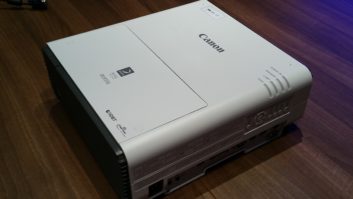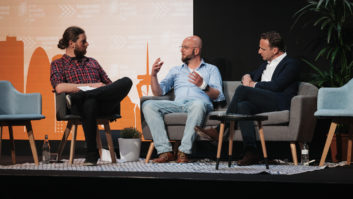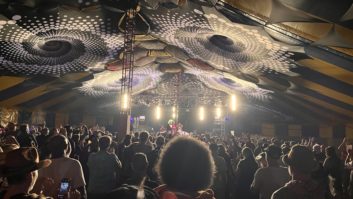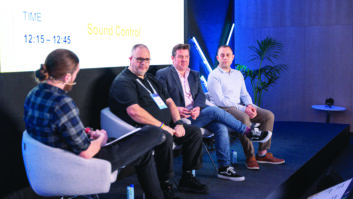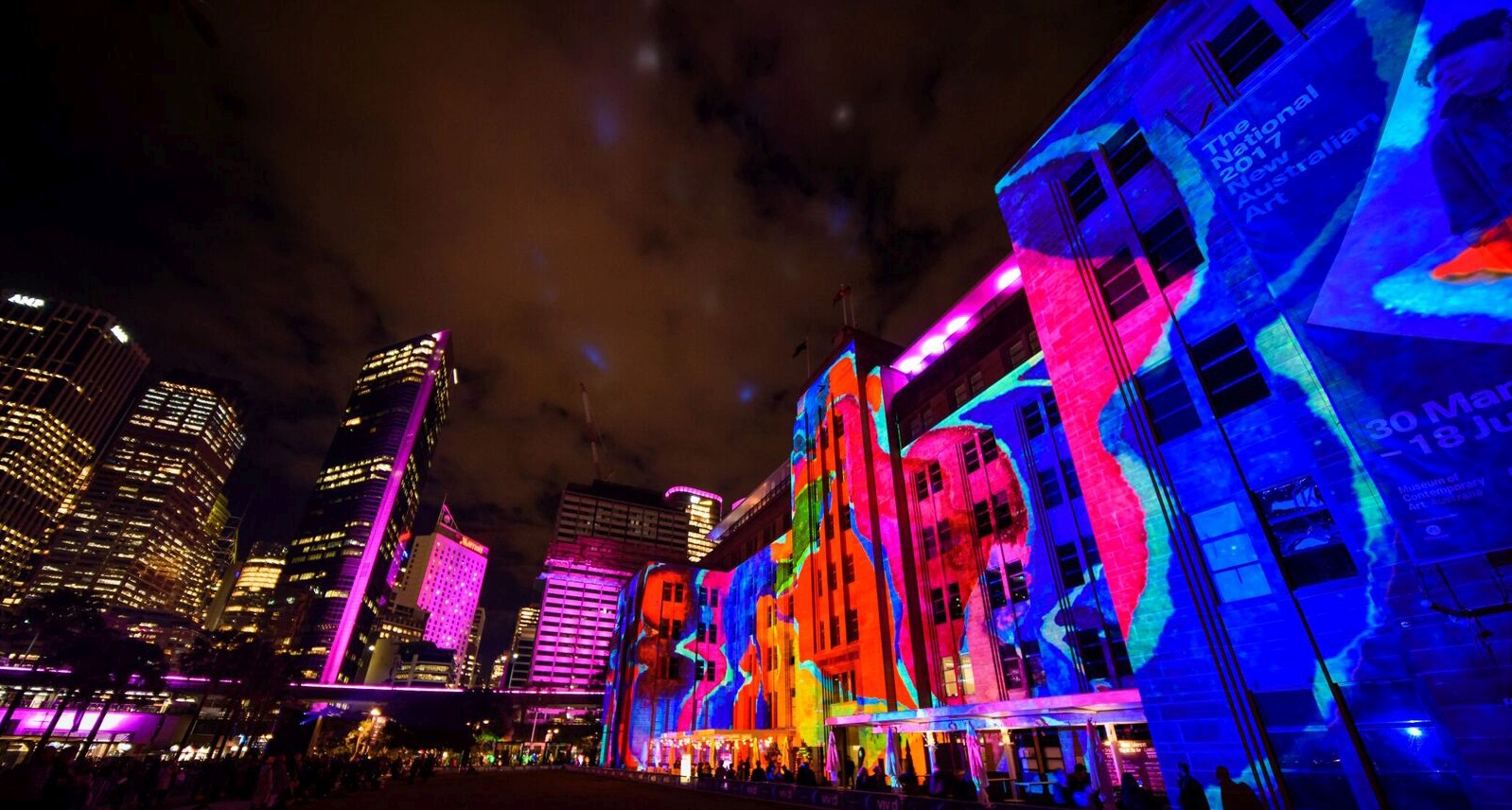
There was a time when, whether the event was a user summit, a product launch, a gala dinner, a sales conference or a grand opening, it meant little more than wheeling out the office projector, glitzing up a few PowerPoint slides – and perhaps adding some really whizzy animations or transitions. (And, usually, way too many of them…)
Now, the requirement is to create the elusive ‘Wow!’ factor, with AV technology likely to play a vital role in delivering a memorable experience. And: if captivating images are part of the creative vision, then projectors are still likely to be involved – but projectors that are significantly superior to those 350 lumen, SVGA projectors of yore.
“The market for projection in live corporate events is continuously growing,” says Lucy Meredith, UK product marketing specialist for Panasonic Visual System Solutions. “This is being pushed even further with the progressive move towards high-brightness laser technology, projection mapping and live content generation and tracking technology – allowing for much greater creativity and a far greater impact.”
Perfect technology
“Projection is the perfect technology to support live corporate events,” notes Thomas Walter, section manager, strategic product marketing at NEC Display Solutions Europe. “It is highly flexible in delivering large, bright images, scalable to achieve the desired impact whilst adapting to the challenges of the infrastructure.”
“Corporate live events are a traditional space for projection as it is well suited for it,” believes Curtis Lingard, senior product manager at Christie Digital. “Projection delivers high resolution and high reliability while being fast and easy to install when you have limited time for setup/teardown. Projection also offers flexibility in terms of size options with a simple change of the lens used or the placement of the projector relative to the screen.”
“The market for projection in corporate live events is one of our core target areas and one that represents massive growth potential for Epson across Europe,” says Neil Colquhoun, Epson executive director EMEAR, professional displays. “Customers don’t always realise the huge potential and stunning results that projection can deliver.”
Both he and Lingard note that the new generation of LED displays have their place and can, in fact, be complementary to projection.
More versatile and immersive
“Many customers choose LED to overcome the problems of shadows and ambient light,” adds Colquhoun’s colleague Lee Harrison, who is market development manager, professional displays at Epson Europe, “but new advancements in projection, with higher brightness, ultra-short-throw lenses and 3LCD technology mean that this is no longer an issue and, in fact, projection offers a far more versatile and immersive display.”
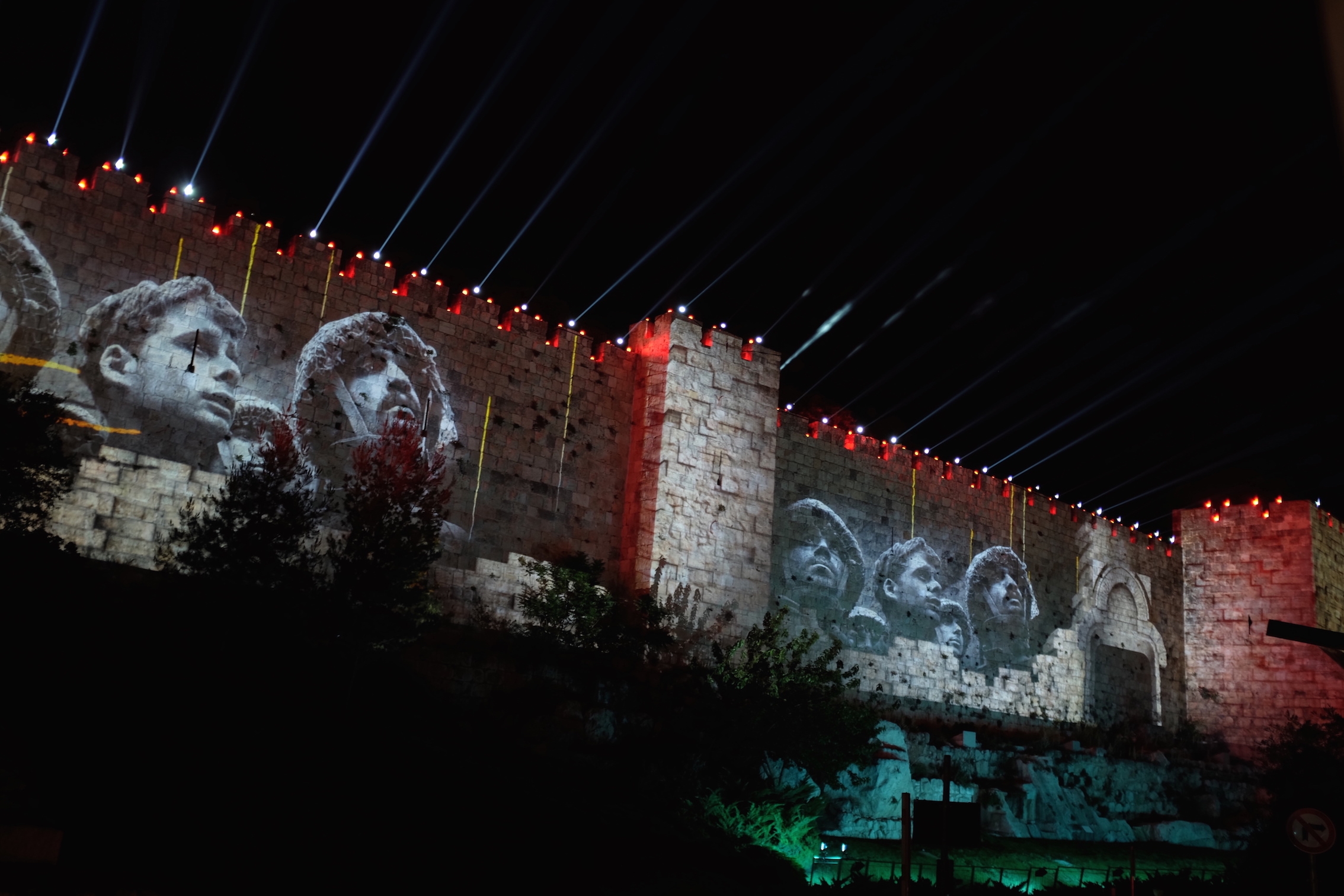
He has an ally in Mark Wadsworth, international marketing manager at Digital Projection.
“We see the market growing into ever more elaborate content and interaction,” he says. “In the past, projection at these type of events would be typically used to display a large presentation or similar, but events are becoming more immersive with companies wanting to tell their story with large panoramas, engage with live streams, or have their corporate ID mapped on their products and so on. While LED walls can satisfy specific requirements, time and power constraints often make this a more suitable option only for the largest events with longer setup times.”
Certainly, projection technology has come a long way – not least in that it’s much more reliable: that’s a key consideration in any high profile event.
“Projectors are getting brighter and smaller, making setup a lot easier than it was five years ago,” continues Wadsworth. “Also, with the advent of solid-state laser phosphor projectors, there’s no longer the risk of seeing a single Xenon lamp go down half way through a show – meaning far greater peace of mind.”
Transformative
Certainly, one of the most transformative technologies to have reached projection – and which has almost single-handedly brought a new lease of life to the projector market – has been so-called solid-state illumination.
“We’re seeing laser and laser phosphor projectors to the fore with higher brightness, richer colours and deeper blacks – creating even more memorable experiences,” says Lingard. “We’re also seeing software tools such as Christie Mystique that helps integrators minimise risk with pre-installation modelling and testing before any hardware is actually installed.”
“Laser light sources have made a huge impact on this sector,” agrees Walter. “Long lasting and reliable performance and brightness with limited maintenance helps rental companies to ensure quick and easy install/reinstall whilst delivering the impact their customers demand. Costs relating to lamp exchange, storage and maintenance are vastly reduced.”
Well: not quite ‘single-handedly’… Another significant contributor to a renaissance in the projector market has been the availability of short throw and ultra-short throw lenses, as Harrison noted earlier – meaning far greater flexibility in projector placement.
“We have seen an uplift in the use of projectors that are capable of quality projection at a short distance,” says Meredith. “The small shift and zoom range of such lenses increases flexibility, making for easier planning and installation.”
Rapid expansion
And then there’s resolution and brightness.
“Over the past few years we’ve seen a rapid expansion in 4K and 10,000+ lumen projectors that make it much easier and more affordable for event organisers to see their vision executed accurately,” explains Rob Meakin, European product manager at Sony Professional Solutions Europe.
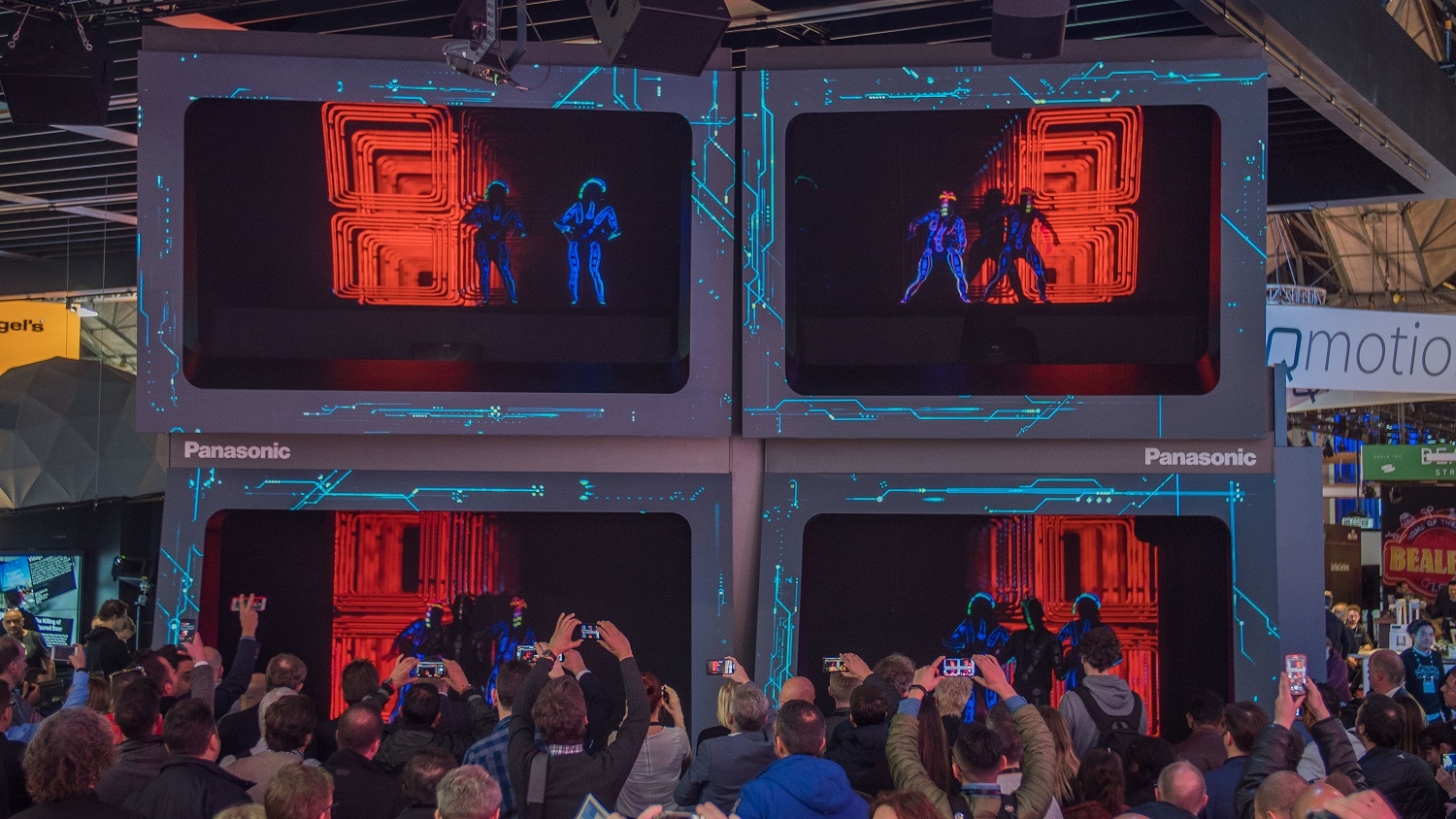
But when it comes to creating the truly spectacular, the projection technology that has perhaps done more than any other to revolutionise what’s possible is mapping – the ability to display images on real world objects, such as cars or building facades.
Meredith again. “Projection mapping is often allied with live content generation and tracking technology,” she says, “This has allowed for much greater creativity and a far greater impact, creating endless opportunities for guest engagement.”
Anyone who was in downtown Amsterdam during ISE 2018 would agree that projection mapping really is something special: the World Masters of Projection Mapping competition saw fantastic images being delivered onto the iconic EYE Filmmuseum. On the company’s stand at the RAI, Panasonic created a must-see projection mapping show by combining visual art performers, laser projection technology, 3D mapping and tracking – the latter by Blacktrax.
At the previous year’s show, Epson deployed 14 laser installation projectors to map onto an F1 car mounted on the wall. Patterned projection windows encircled the car, filled with linked narratives, one of which followed the car, moving from the grid onto an F1 circuit, before transforming into bursts of vibrant colours, shapes and effects. Remarkably, set-up is said to have taken just 36 hours.
Creative and memorable
It’s not, however, just about illuminating buildings or showing off at trade shows.
“Some of the more creative and memorable events I’ve been involved with have used projection mapping across the entire interior of the venue to transform the location into a completely new environment and transport the audience to a whole new immersive world,” enthuses Lingard.
Almost as important as developments in projection mapping, and no less crucial in many scenarios where the requirement is to deliver impressive images, has been edge blending.
“The most imaginative uses of projection I usually see at corporate events involve multiple projectors and edge blending,” recalls Meakin. “It’s possible to blend multiple projectors to create one super high resolution, super-size image that will ensure crystal clear image quality.”
One of the applications that edge blending particularly lends itself to is the creation of surround sound – but in visual form.
“We have seen fully immersive domes being deployed for corporate events, as well as 180 or even 360 degree panoramas,” says Wadsworth. “These things can sometimes be taken for granted in the pro AV world as they have been seen a hundred times before – but for guests who aren’t in this industry, they can be truly awe-inspiring.”
Raising the bar
Projection has, then, come a long way in recent years, continuing to raise the bar in terms of its ability to deliver the truly astonishing – which is what many corporate events organisers are surely looking for. What, though, does an organiser need to do to ensure that that potential is fully leveraged?
“An assessment of the context and objectives of the event is the first step,” says NEC’s Walter. “The size of the venue, viewing distance, lighting conditions and infrastructure are all critical factors alongside the strategic objectives of the event. If the presentation is to be projected onto a screen, should it be front or rear projection? This will depend on the space and infrastructure available.”
That analysis will likely to transpire to more practical considerations.
“Organisers need to look at the size of the projection areas and the space available to house the projector, the brightness required and the throw distances required,” states Panasonic’s Meredith.
“If it is a day time event with lots of daylight, organisers will require either a very bright projector, teamed with an appropriate ambient light-rejecting screen, or to consider another solution,” adds Digital Projection’s Wadsworth. “They should also check what power is available; a lot of the high end projectors only operate with 3-phase electricity. Not checking the plug or available power before the event could be a showstopper. Luckily, this is becoming less of an issue now as projectors are getting brighter and brighter and can be run from a normal mains connection.”
As Wadsworth implies: the devil is often in the detail. Sony’s Meakin echoes those sentiments.
“Ensure the correct inputs and cables are all available on the day,” he says. “When AV ‘goes wrong’, it’s never the projector that has malfunctioned. It’s the cable – or lack thereof; the resolution of the content; or even the output device – the PC or video and so on.”
Maximising the benefit
The foregoing are just some of the basics. But what about truly maximising the benefit of today’s projection technology? The industry is agreed on the appropriate course of action.
“It’s important that corporate customers work closely with integrators and rental companies to develop a solution that is right for them and that they are happy with,” recommends Meredith. “Utilise their knowledge and experience to best advise you on what the best solution to make the most out of your corporate live event.”
“Decide what you want, and then call in the visual display technology experts to make your vision a reality,” echoes Lingard. “Their industry knowledge, experience, and advice is invaluable. Most importantly, organisers should clearly understand what they want to show and what impact they want from the visuals. This will allow suppliers to ensure they deliver the desired experience, and not just equipment.”
Huge impact
The last word goes to Epson’s Colquhoun.
“AV, and especially projection, can make a huge impact,” he smiles. “A fully immersive and highly visual experience can make the difference between a returning customer at an event experience or a delegate at a presentation. Certainly, the regular feedback we’ve had from customers is that the excitement created by an event has more than paid for their investment in it.”
And if ROI is the key, as it so often is, that’s a pretty ringing endorsement.
With so many creative possibilities, and so much expertise available to turn a presentation into a memorable spectacular, there is, it seems, no longer any excuse for death by PowerPoint.

